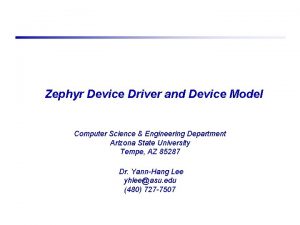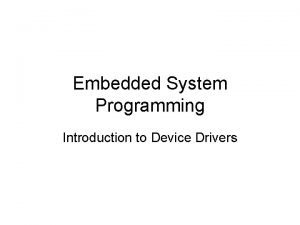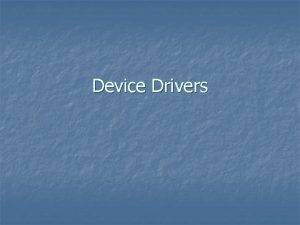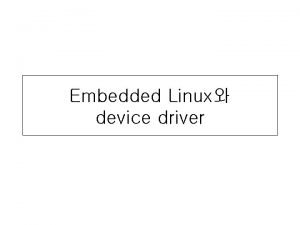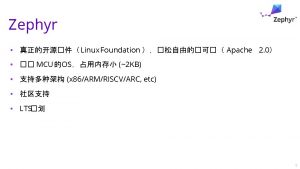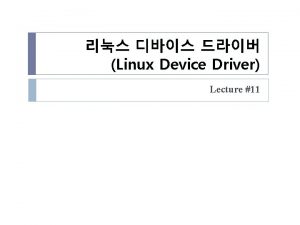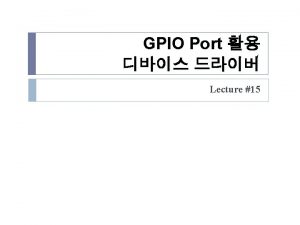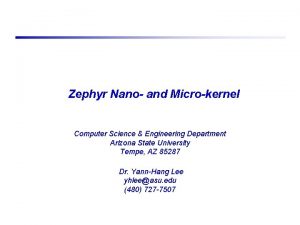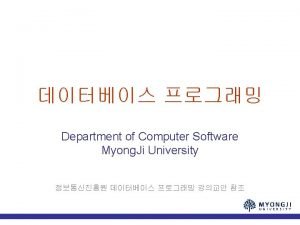Zephyr Device Driver and Device Model Computer Science











- Slides: 11

Zephyr Device Driver and Device Model Computer Science & Engineering Department Arizona State University Tempe, AZ 85287 Dr. Yann-Hang Lee yhlee@asu. edu (480) 727 -7507

Device Model q To support initializing all the drivers configured into the system v The driver fills in the pointer to the structure containing the function pointers to its API functions during driver initialization. v These structures are placed into the RAM section in initialization level order. q To provide a generic type API for each type of driver (UART, SPI, I 2 C) v can be used by fibers and tasks q API calls may be blocked for synchronous IO operations v must use proper mechanisms for blocking according to execution context, e. g. , a nanokernel semaphore cannot be used when the context is a task. v Synchronous calls API typedef struct { type /** Nanokernel semaphore for fiber context */ struct nano_sem f_sem; device_sync_call_t #ifdef CONFIG_MICROKERNEL /* use microkernel semaphore */ inline functions struct _k_sem_struct _t_sem; ksem_t t_sem; device_sync_call_init() enum device_sync_waiter; device_sync_call_init() bool device_ready; #endif device_sync_call_init() } device_sync_call_t; CSE 530 EOSI Fall 2016 1

Driver APIs q The runtime device struct per driver instance struct device { struct device_config *config; void *driver_api; void *driver_data; }; struct device_config { char *name; int (*init)(struct device *device); void *config_info; }; q DEVICE_INIT() v create device object and set it up for boot time initialization. q DEVICE_AND_API_INIT() v Create device object and set it up for boot time initialization. This also takes a pointer to driver API struct for link time pointer assignment. q DEVICE_NAME_GET() v Expands to the full name of a global device object. q DEVICE_GET() v Obtain a pointer to a device object by name. q DEVICE_DECLARE() v Declare a device object. CSE 530 EOSI Fall 2016 2

Device Initialization – DEVICE_INIT() #define DEVICE_AND_API_INIT(dev_name, drv_name, init_fn, data, cfg_info, level, prio, api) static struct device_config __config_##dev_name __used __attribute__((__section__(". devconfig. init"))) = { . name = drv_name, . init = (init_fn), . config_info = (cfg_info) }; static struct device (__device_##dev_name) __used __attribute__((__section__(". init_" #level STRINGIFY(prio)))) = { . config = &(__config_##dev_name), . driver_api = api, . driver_data = data } q defines a device object that is automatically configured by the kernel during system initialization v two static struct __config##dev_name and __device_##dev_name v place them in “. devconfig. init” and “init_ #level STRINGFFY(prio)” sections q invoke_sys_device_do_config_level() to call device->init() CSE 530 EOSI Fall 2016 3

Driver Example: i 2 c_dw DEVICE_AND_API_INIT(i 2 c_0, CONFIG_I 2 C_DW_0_NAME, &i 2 c_dw_initialize, &i 2 c_0_runtime, &i 2 c_config_dw_0, SECONDARY, CONFIG_I 2 C_INIT_PRIORITY); q initialization func – i 2 c_dw_initialize() q driver API functions q config_data and driver_data struct i 2 c_dw_dev_config { device_sync_call_t sync; union dev_config app_config; uint 8_t *xfr_buf; uint 32_t xfr_len; uint 32_t rx_pending; uint 16_t hcnt; uint 16_t lcnt; volatile uint 8_t state; /* last dir. of transfer */ uint 8_t request_bytes; uint 8_t xfr_flags; bool support_hs_mode; }; CSE 530 EOSI Fall 2016 static struct i 2 c_driver_api funcs = {. configure = i 2 c_dw_runtime_configure, . transfer = i 2 c_dw_transfer, . suspend = i 2 c_dw_suspend, . resume = i 2 c_dw_resume, }; struct i 2 c_dw_rom_config { uint 32_t base_address; uint 32_t irq_num; uint 32_t interrupt_mask; #ifdef CONFIG_PCI struct pci_dev_info pci_dev; #endif /* CONFIG_PCI */ i 2 c_isr_cb_t config_func; #ifdef CONFIG_I 2 C_DW_SHARED_IRQ char *shared_irq_dev_name; #endif /* CONFIG_I 2 C_DW_SHARED_IRQ */ }; 4

Bit-Transfer on I 2 C Bus q One clock pulse is generated for each data bit that is transferred q Data Validity v The data on the SDA line must be stable during the HIGH(1) period of the clock. The data line(SDA) can change data only when the clock signal (SCL) is LOW(0) q Wired-and function v open-drain or opencollector CSE 530 EOSI Fall 2016 5

Data Transfer With 7 -Bit Device Address q After START condition (S), a slave address(7 -bit) is sent. q A read/write (R/W’) direction is then sent(8 th bit) q Data transfer occurs, and then always terminated by STOP condition. However, repeated START conditions can occur. CSE 530 EOSI Fall 2016 6

Master-Transmitter to Slave-Receiver Data Transfer q In this, the transmission direction never changes. The set-up and transfer is straight-forward CSE 530 EOSI Fall 2016 7

Master-Receiver and Slave-Transmitter Data Transfer q Master initiates the data transfer by generating the START condition followed by the start byte (with read/write bit set to 1 i. e. read mode) q After the first ack from the slave, the direction of data changes and the master becomes receiver and slave transmitter. q The STOP condition is still generated by the master (master sends not-ACK before generating the STOP) CSE 530 EOSI Fall 2016 8

Example I 2 C Device – 24 FC 256 EEPROM q 32 K bytes in 512 pages of 64 bytes q I 2 C interface with A 2, A 1, A 0 address pins q Page write operation: q Random read operation: CSE 530 EOSI Fall 2016 9

Use of I 2 C Driver in Galileo Board q CONFIG_I 2 C_0=y in /zephyr/boards/galileo_defconfig q I 2 C interface wrapper in /zephyr/include/i 2 c. h static int i 2 c_transfer(struct device *dev, struct i 2 c_msg *msgs, uint 8_t num_msgs, uint 16_t addr) q Need to find the “struct device” q Search the device objects by configuration name v With DEVICE_INIT macro, the objects are placed in memory by the linker. struct device *device_get_binding(char *name) { struct device *info; for (info = __device_init_start; info != __device_init_end; info++) { if (!strcmp(name, info->config->name)) { return info; } } return NULL; } CSE 530 EOSI Fall 2016 10
 Device_and_api_init
Device_and_api_init Wfhs zephyr
Wfhs zephyr Assurance zephyr
Assurance zephyr Windows driver foundation user mode driver framework
Windows driver foundation user mode driver framework Hardware output
Hardware output What are your favorite subjects?
What are your favorite subjects? Device driver programming in embedded systems
Device driver programming in embedded systems Computer drivers definition
Computer drivers definition Windows ce device driver
Windows ce device driver Linux device driver
Linux device driver Device driver does not support hardware shadow maps
Device driver does not support hardware shadow maps Wddm 3
Wddm 3
